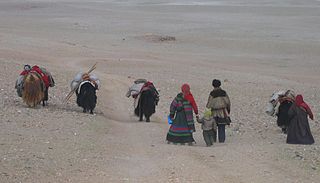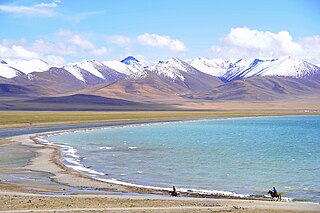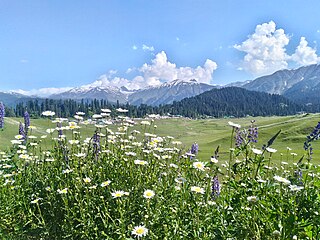
The Himalayas, or Himalaya is a mountain range in Asia, separating the plains of the Indian subcontinent from the Tibetan Plateau. The range has some of the Earth's highest peaks, including the highest, Mount Everest. More than 100 peaks exceeding elevations of 7,200 m (23,600 ft) above sea level lie in the Himalayas.

The Karakoram is a mountain range in the Kashmir region spanning the border of Pakistan, China, and India, with the northwestern extremity of the range extending to Afghanistan and Tajikistan. Most of the Karakoram mountain range falls under the jurisdiction of Gilgit-Baltistan, which is controlled by Pakistan. Its highest peak, K2, is located in Gilgit-Baltistan, Pakistan. It begins in the Wakhan Corridor (Afghanistan) in the west, encompasses the majority of Gilgit-Baltistan, Pakistan and extends into Ladakh and Aksai Chin.

The Tibetan Plateau, also known as Qinghai–Tibet Plateau and Qing–Zang Plateau, is a vast elevated plateau located at the intersection of Central, South, and East Asia covering most of the Tibet Autonomous Region, most of Qinghai, western half of Sichuan, Southern Gansu provinces in Western China, southern Xinjiang, Bhutan, the Indian regions of Ladakh and Lahaul and Spiti as well as Gilgit-Baltistan in Pakistan, northwestern Nepal, eastern Tajikistan and southern Kyrgyzstan. It stretches approximately 1,000 kilometres (620 mi) north to south and 2,500 kilometres (1,600 mi) east to west. It is the world's highest and largest plateau above sea level, with an area of 2,500,000 square kilometres (970,000 sq mi). With an average elevation exceeding 4,500 metres (14,800 ft) and being surrounded by imposing mountain ranges that harbor the world's two highest summits, Mount Everest and K2, the Tibetan Plateau is often referred to as "the Roof of the World".

Valley of Flowers National Park is an Indian national park which was established in 1982. It is located in Chamoli in the state of Uttarakhand and is known for its meadows of endemic alpine flowers and the variety of flora. This richly diverse area is also home to rare and endangered animals, including the Asiatic black bear, snow leopard, musk deer, brown bear, red fox and blue sheep. Birds found in the park include Himalayan monal pheasant and other high-altitude birds.

Alpine plants are plants that grow in an alpine climate, which occurs at high elevation and above the tree line. There are many different plant species and taxa that grow as a plant community in these alpine tundra. These include perennial grasses, sedges, forbs, cushion plants, mosses, and lichens. Alpine plants are adapted to the harsh conditions of the alpine environment, which include low temperatures, dryness, ultraviolet radiation, wind, drought, poor nutritional soil, and a short growing season.
Saussurea laniceps is a rare snow lotus found only in the Himalayas including southwest China. It might also occur in northern Burma. It grows above about 3,200 m (10,500 ft) altitude on alpine scree slopes. It is reputed to have medicinal properties according to traditional Chinese medicine. Among the snow lotus, Saussurea laniceps is proven to be more effective for its anti-inflammatory and anti-nociceptive effects.

Pin Valley National Park is a National park of India located in the Spiti Valley in the Lahaul and Spiti district, in the state of Himachal Pradesh. It is located in far northern India. It is part of Cold Desert.

Hemis National Park is a high-elevation national park in Hemis in Leh district of Ladakh, India. It approx. 50 km from Leh, the capital of Ladakh. Globally famous for its snow leopards, it is believed to have the highest density of them in any protected area in the world. It is the only national park in India that is north of the Himalayas, the largest notified protected area in India and is the second largest contiguous protected area, after the Nanda Devi Biosphere Reserve and surrounding protected areas. The park is home to a number of species of endangered mammals, including the snow leopard. Hemis National Park is India's protected area inside the Palearctic realm, outside the Changthang Wildlife Sanctuary northeast of Hemis, and the proposed Tso Lhamo Cold Desert Conservation Area in North Sikkim.

The Himalayan marmot is a marmot species that inhabits alpine grasslands throughout the Himalayas and on the Tibetan Plateau. It is IUCN Red Listed as Least Concern because of its wide range and possibly large population.

Deosai National Park is a high-altitude alpine plain and national park located between the Skardu District, Kharmang District and Astore District in Gilgit-Baltistan, Pakistan.

Gurla Mandhata, also Naimona'nyi or Namu Nani, is the highest peak of the Nalakankar Himal, a small subrange of the Himalaya. It lies in the northwest corner of Nepal. It is the 34th-highest peak in the world. It is also notable for being well within the interior of the Tibetan Plateau and relatively far away from other peaks with heights greater than 7,500 metres. It sits roughly across Lake Manasarovar from the sacred peak of Mount Kailash.

The Changtang is a part of the high altitude Tibetan Plateau in western and northern Tibet extending into the southern edges of Xinjiang as well as southeastern Ladakh, India, with vast highlands and giant lakes. From eastern Ladakh, the Changtang stretches approximately 1,600 kilometres (990 mi) east into Tibet as far as modern Qinghai. The Changtang is home to the Changpa, a nomadic Tibetan people. The two largest settlements within the Tibetan Changtang are Rutog Town the seat of Rutog County and Domar Township the seat of Shuanghu County.

Taxus wallichiana, the Himalayan yew, is a species of yew, native to the Himalaya and parts of south-east Asia. The species has a variety of uses in traditional medicine. It is currently classified as endangered by the IUCN.

Dolomiaea costus, formerly known as Saussurea costus, commonly known as costus, Indian costus,kuth, or putchuk, is a species of thistle in the genus Dolomiaea native to South Asia and China. Rishi (Hindu) mystics of Kashmir especially ate this plant. Essential oils extracted from the root have been used in traditional medicine and in perfumes since ancient times.

The Trans himalaya, or "Gangdise – Nyenchen Tanglha range", is a 1,600-kilometre-long (990 mi) mountain range in China, India and Nepal, extending in a west–east direction parallel to the main Himalayan range. Located north of Yarlung Tsangpo river on the southern edge of the Tibetan Plateau, the Transhimalaya is composed of the Gangdise range to the west and the Nyenchen Tanglha range to the east.

Qilian County, in Tibetan Dhola County, is a county of Haibei Tibetan Autonomous Prefecture, Qinghai Province, China. The Haibei Qilian Airport is located in the county.

Chandra Prakash Kala is an Indian ecologist and professor. His research interests include alpine ecology, conservation biology, indigenous knowledge systems, ethnobotany and medicinal aromatic plants. He is an assistant professor in the faculty area of Ecosystem and Environment Management at the Indian Institute of Forest Management.

Sichuan pepper, also known as Szechuan pepper, Szechwan pepper, Chinese prickly ash, Chinese pepper, Mountain pepper, and mala pepper, is a spice commonly used in Sichuan cuisine in China, in Nepal, and in northeast India. Despite its name, Sichuan pepper is not closely related to black pepper or chili peppers. It is made from plants of the genus Zanthoxylum in the family Rutaceae, which includes citrus and rue.
Jan Salick is an American botanist who researches the interaction between humans and plants (ethnobotany) and conservation biology. Her specialisms include alpine environments, climate change, indigenous peoples and traditional knowledge. She is a past-president of the Society for Economic Botany and holds their Distinguished Economic Botanist award. She is also Fellow of the American Association for the Advancement of Science and received the Fairchild Medal for Plant Exploration. In 2019 she retired as Senior Curator of Ethnobotany at the Missouri Botanical Garden, and now has emerita status.

The Gulmarg Wildlife Sanctuary spread over 180 square kilometres (69 sq mi) is a protected area in Gulmarg, Baramulla district of Jammu and Kashmir, India. The sanctuary lies on the north-eastern side of the Pir Panjal mountain range and falls under the northwest Biogeographic Zone 2A. It lies 50 kilometres (31 mi) south-west of Srinagar and 26 kilometres (16 mi) from Baramulla. The sanctuary was first declared as a game reserve in 1981 and later upgraded to a sanctuary in 1987.























